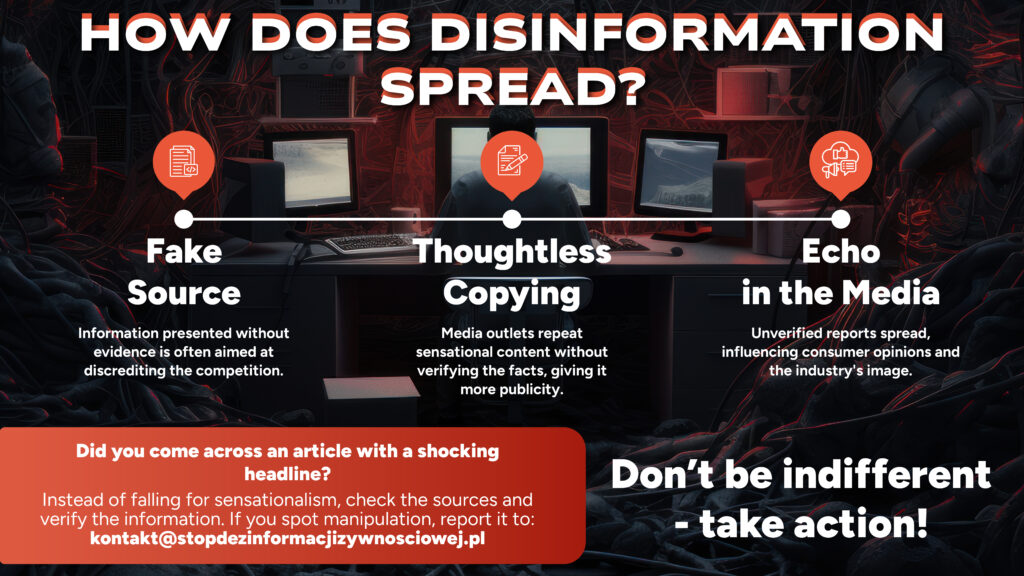Disinformation: How Misleading Narratives Threaten Our Food

In a world saturated with information—where an Instagram reel can shape public opinion more than a peer-reviewed study—food disinformation poses a serious risk. It is the deliberate spread of misleading content—falsehoods, distortions, or exaggerations—driven by emotions such as fear and anger that bypass critical thinking. In the food sector, it increasingly damages producer reputations, erodes trust in science and safety oversight, confuses consumers, distorts choices, and can tarnish entire industries, especially meat production. Once doubt takes root, it is hard to reverse, as sensationalism often outpaces truth in today’s fast-paced media.
The National Poultry Council – Chamber of Commerce (KRD-IG), the leading voice of Poland’s poultry sector, is taking decisive action to tackle it. Through its wide-reaching educational campaign #StopDezinformacjiŻywnościowej (#StopFoodDisinformation), the organisation is working to expose misleading claims, explain how manipulation spreads, and restore credible, evidence-based knowledge to the public discourse. At the heart of the campaign is a comprehensive, freely available e-book, which explains how to recognise and avert disinformation and false narratives. The campaign utilises social media, expert partnerships, and rapid myth-busting to help consumers make fact-based, rather than fear-driven, decisions.
The “White Stripes” Case and The Goose Meat Scandal
One of the most striking examples of food-related disinformation is the so-called “white stripes” case in poultry meat. The phenomenon, scientifically known as white striping, is a harmless muscle characteristic. However, some media outlets and activist groups portrayed it as a sign of disease or industrial malpractice, sparking needless fear and concern. Terms such as “unhealthy meat”, “proof of factory farming”, and even “consumer risk” were widely circulated—despite no scientific evidence supporting any of these claims. In truth, white striping can appear in poultry regardless of the farming method, including organic systems. It does not impact the meat’s nutritional value or safety in any way. And yet, this false narrative took hold. The result? A noticeable decline in consumer trust and a drop in demand for one of the most widely recommended protein sources in Poland and across Europe.
Another case of damaging disinformation involved Polish goose meat. Media reports made sensational claims about unethical fattening practices and suggested that old, frozen meat was being sold as fresh. These claims made it into the media through sensationalist headlines—without fact-checking, without source verification, and without offering producers a chance to respond. In reality, force-feeding geese has been banned in Poland since 1999. Today, Polish goose production follows some of the most stringent EU standards, and exported goose meat is among the most carefully monitored animal products on the market. Yet, one misinformed interview was enough to spark a wave of mistrust and severely tarnish the industry’s reputation. Despite corrections and expert statements, the truth lagged behind sensational headlines, shaking consumer confidence and leaving producers to handle the fallout—showing how quickly misinformation can harm public opinion and national agriculture.
Fake Tests and False Inspectors – How Online Scams Erode Trust in Food
A more recent and equally worrying trend is the spread of pseudo-scientific “tests” on social media, often conducted by self-proclaimed inspectors claiming to detect toxins in poultry meat. Videos reaching millions of viewers show tests carried out using uncertified devices of Russian manufactured tools with no diagnostic validity, capable of distorting results by as much as 3,000%. The creators of such content—who lack any formal qualifications or scientific expertise—deliberately stoke fear and mistrust, suggesting that Polish poultry poses a health risk. In contrast, certified laboratories and official inspections consistently confirm that antibiotic and nitrate levels remain well within the legal limits. As the Chief Veterinary Officer has made clear, the only trustworthy data comes from accredited institutions conducting research under EU-approved standards. These fake online “experiments” mislead consumers and seriously harm the agri-food sector, showing how easily unchecked, emotion-driven claims can manipulate public opinion.
KRD-IG’s E-Book: A Trusted Guide Worth Keeping Close
In response to the growing flood of food-related disinformation, the KRD-IG has released a new e-book: “Food Disinformation: How to Identify It and Respond”—the first practical, in-depth guide to how misleading narratives take hold in the public space. This new e-book clearly explains how disinformation spreads, provides real-life examples of media manipulation, offers tools to identify fake news and clickbait, and provides guidance on finding reliable information. It demonstrates how even seemingly harmless phenomena or individual comments can be exploited against entire industries. The publication is not only aimed at agri-food professionals but is also useful for students, educators, and anyone who wants to make informed consumer choices. Food falsehoods do not only harm businesses: farmers face unfounded accusations, producers see their products unfairly boycotted, and consumers avoid healthy, high-quality foods, with repercussions for the economy and Poland’s reputation as a European leader in poultry. In a digital world where anyone can publish content, the responsibility to verify information lies with us all: checking sources and verifying facts is the only way to curb the spread of disinformation.

More information and resources available at: www.stopdezinformacjizywnosciowej.pl
Article adapted from the original: “Fałsz, który smakuje sensacją. Jak dezinformacja zagraża temu, co jemy – i co z tym robi KRD-IG“, by ELV Poland